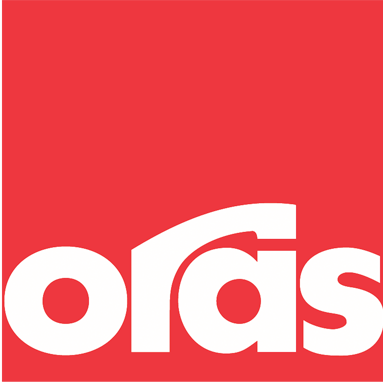Wondering about sanitary guidelines and ergonomics in medical facilities? Here’s how to elevate hygiene, safety and comfort in sensitive environments by choosing the right faucet.
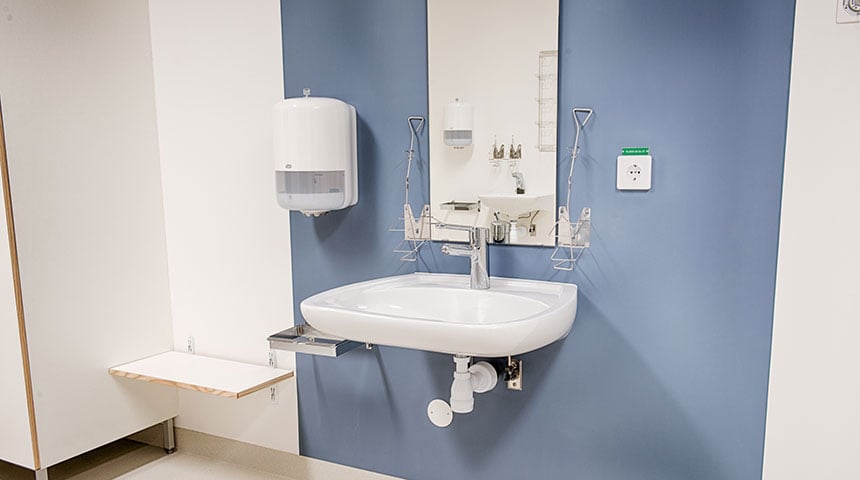
Patient room with Oras Medipro washbasin faucet
From doctors to nurses and patients, if there is one fitting that’s used by everyone in a hospital building, it’s the faucet. But installing faucets in medical facilities is not a one-size-fits-all project. Faucets have to satisfy the needs of a range of different users, from patients to doctors, nurses and visitors.
Apart from ensuring long-lasting operations and a high level of hygiene, what else should project planners take into account?
Here’s a guide to choosing the right faucet in healthcare facilities.
Create a bacteria-free environment
The European Centre for Disease Control estimates that every year, up to 3.7 million people acquire a healthcare-associated infection when visiting acute care hospitals in the EU.
20 percent of these healthcare-associated infections are considered avoidable if better infection prevention and control were in place.
To reduce the spread of bacteria and meet the highest standards of quality and functionality, hospital buildings rely on easy-to-clean, easy-to-use and bacteria-free equipment.
Let’s have a look at the most important parameters.
Highly functional faucets for highly functional units
Whether it’s a special patient room or an operating theatre, efficient design is key to making optimal use of the available space so beds, wheelchairs, and medical equipment can be moved around freely.
This also includes the design of fixtures, from fitted, space-saving corner basins to optimally designed hospital faucets.
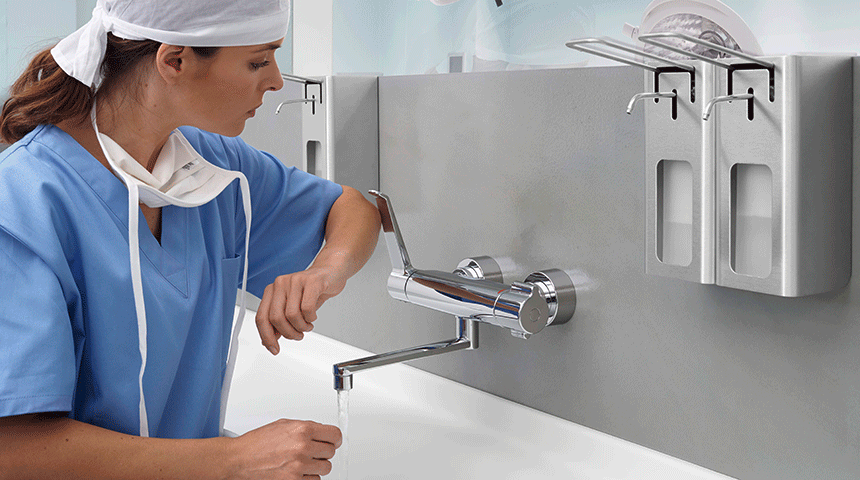
Hospitals and clinics have high requirements and standards for hospital faucets.
Ensure the greatest mobility for challenging tasks
Faucets with a long lever are crucial to simplify daily procedures for staff and patients.
Extra-long levers of models, such as the Oras Medipro or Oras Clinica, for example, are particularly ergonomic for operating personnel. By using the back of the hand or one finger, levers can be lifted easily while maneuvering other medical equipment.
Also available as a wall-mounted model with a swivel spout, both models leave plenty of room under the spout to ensure convenient and hygienic handling.
Further, touchless and elbow-handled faucets can help reduce hand-to-hand transmission of bacteria, making them an ideal choice for high-risk environments, such as the operating theatre.
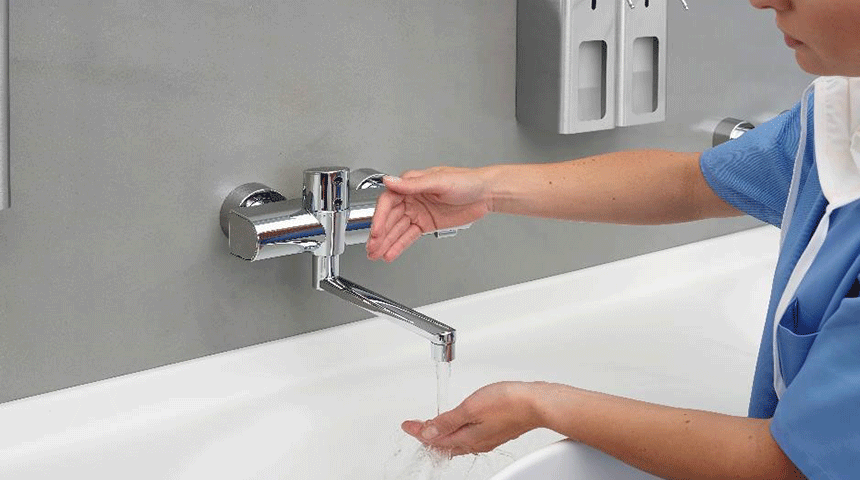
Oras Clinica touchless thermostat is an ideal choice for operating theatres.
Faucet design for antimicrobial spaces
Microbes can hide everywhere. That’s why the right design and material of the faucet are key to minimising the risk of contamination.
Most hospital faucets are equipped with copper inlet pipes. Due to the material’s antimicrobial qualities, these models can significantly limit the number of contaminants inside the pipes and improve water hygiene.
When it comes to the faucet’s design, fully sealed connections with rounded edges and minimum joints can further reduce the spots for microbes to accumulate while guaranteeing a convenient and easy cleaning routine.
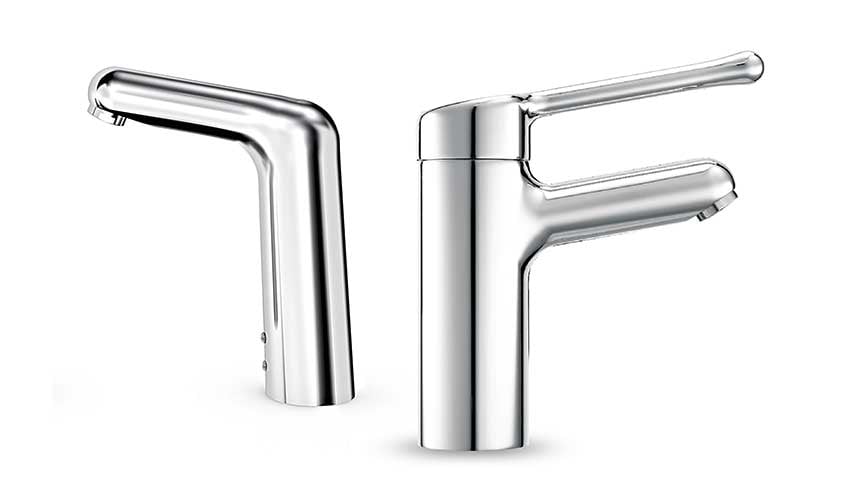
Oras Medipro medical faucets have minimal joints to prevent bacteria build
Investing in dedicated hygiene solutions, such as the touchless Oras Medipro faucets, can reduce hospital-acquired infections by almost 60 percent and meet demanding hygiene standards of future hospital projects.[1]
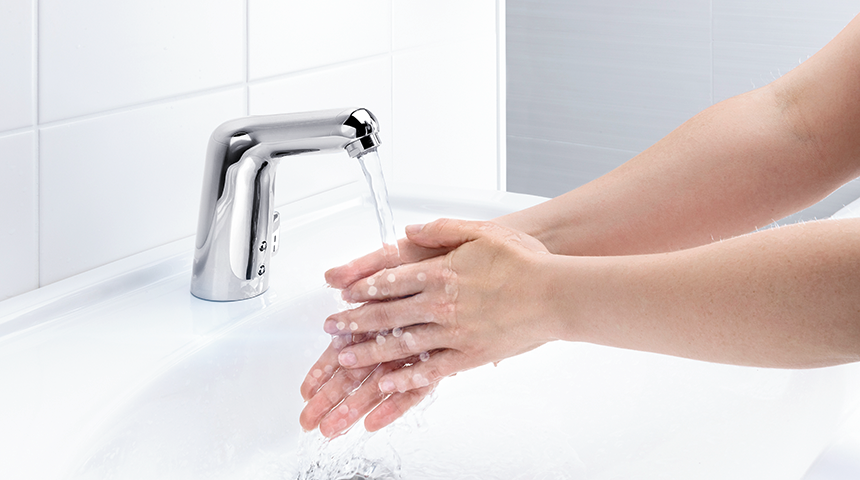
Touchless faucet Oras Medipro with laminar flow
Automatic faucets to minimise touchpoints in staff and patient rooms
Up to 80 percent of the most common diseases are transmitted by touch*. Touchless faucets help staff and patients keep high-usage surfaces as clean and hygienic as possible.
The touchless Oras Electra or the Oras Medipro, for example, help to reduce essential touchpoints responsible for bacteria transmission in public areas of hospitals, such as levers in public bathrooms or patients’ rooms.
Note: Models with premixed water temperature can provide extra comfort and safety by effectively minimising the risk of scalding accidents.
Improve water hygiene in medical buildings
Alongside designing a clean, bacteria-free environment, ensuring optimal water hygiene is another key criterion of high-quality hospital fixtures. That’s why, for medical faucets, these three specialised features are a must-have:
1. Laminar flow
Most standard faucets come with built-in aerators that use a combination of air and water to produce an aerated water stream. In hospitals, however, mixing water with the surrounding air can lead to infectious, breathable droplets entering the room.
Specialised faucet models with incorporated laminar flow remove properties, such as the aerator, to ensure that no aerosol droplets are produced at the faucet - reducing the chance of infected droplets filling the air.
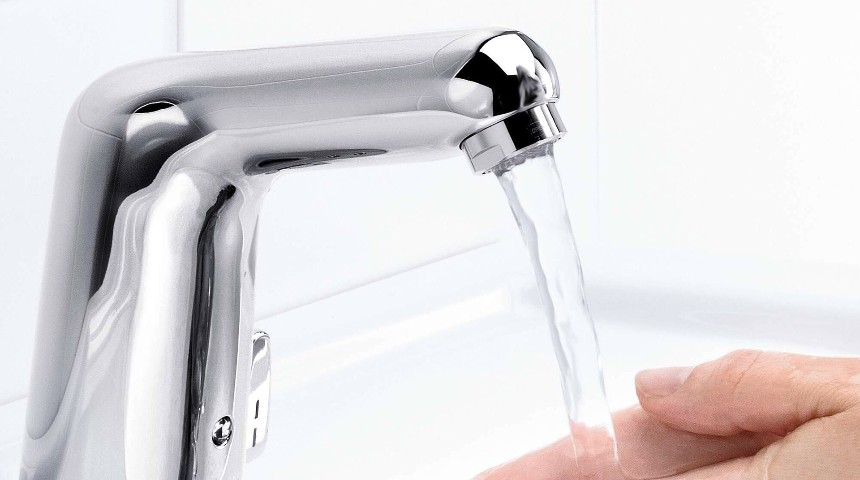
Laminar water flow means there is no aerator in the faucet that would cause water to mix with air.
2. Thermal disinfection
To further limit the risk of bacteria affecting water hygiene, many faucet models feature hygienic flush functions using thermal disinfection. This function makes sure that water is flushed through the pipe at a maximum hot water temperature of 70°C to effectively kill harmful bacteria, such as legionellae.
3. Automatic flushing
In the past years, modern integrated flushing functions have been introduced to the hospital market. This allows building operators to activate frequent flushing of the faucets (e.g., at a 24h interval) to further prevent bacteria from forming in stagnant waters.
Smart solutions with an integrated Bluetooth connection, for example, enable scheduling regular automatic flushing intervals of faucet and pipes by using a convenient mobile app, such as the Oras App.
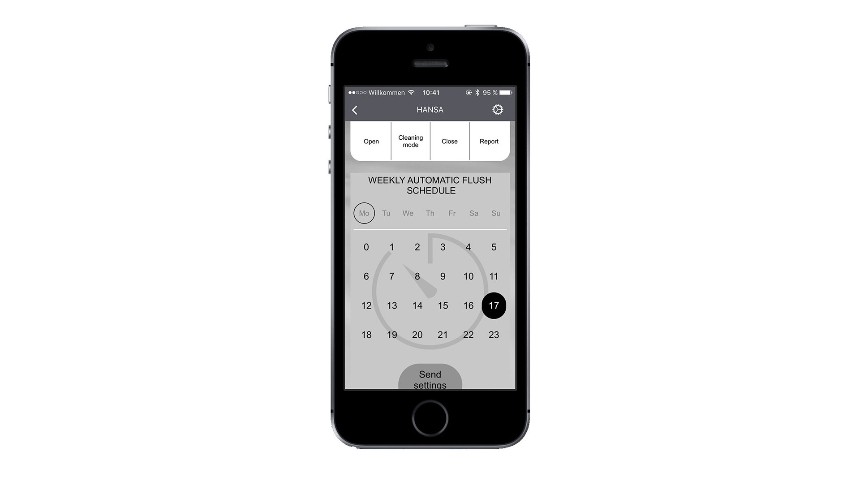
Schedule weekly or daily automatic flush with Oras Connect app
Connect your way to better hygiene and efficiency
Hygienic and easy-to-use fixtures significantly improve the daily operations of hospital staff and usability for patients. And future technologies are predicted to keep advancing usability and infection control.
Alongside scheduled automatic rinsing, modern installations further allow buildings to control and advance overall energy efficiency.
Combined with the smart technology of touchless faucets, for example, water consumption of installed faucets around the building can be reduced by up to 50%, while flow time and after flow can be flexibly monitored and adjusted in the connected app.
Especially in hospital projects, sanitary fittings are expected to live up to a wide range of functionality and hygiene standards. In some cases, you may even need to look for customised solutions to fit the specific criteria of your project.
Find out how Oras collaborates with hospitals to adapt product specifications and provide customised solutions that are adjusted to the needs of medical centres, hospitals, and nursing homes.

[1] Salgado, C., Sepkowitz, K., John, J., Cantey, J., Attaway, H., Freeman, K., . . . Schmidt, M. (2013). Copper Surfaces Reduce the Rate of Healthcare-Acquired Infections in the Intensive Care Unit. Infection Control & Hospital Epidemiology, 34(5), 479-486. doi:10.1086/670207
* Mäkinen R., Miettinen I.T., Pitkänen T., Kusnetsov J., Pursiainen A., Kovanen S., Riihinen K., Keinänen-Toivola M.M. (2013) Manual faucets induce more biofilms than electronic faucets. Canadian Journal of Microbiology, 59(6), 407–412. DOI: 10.1139/cjm-2013-0131



